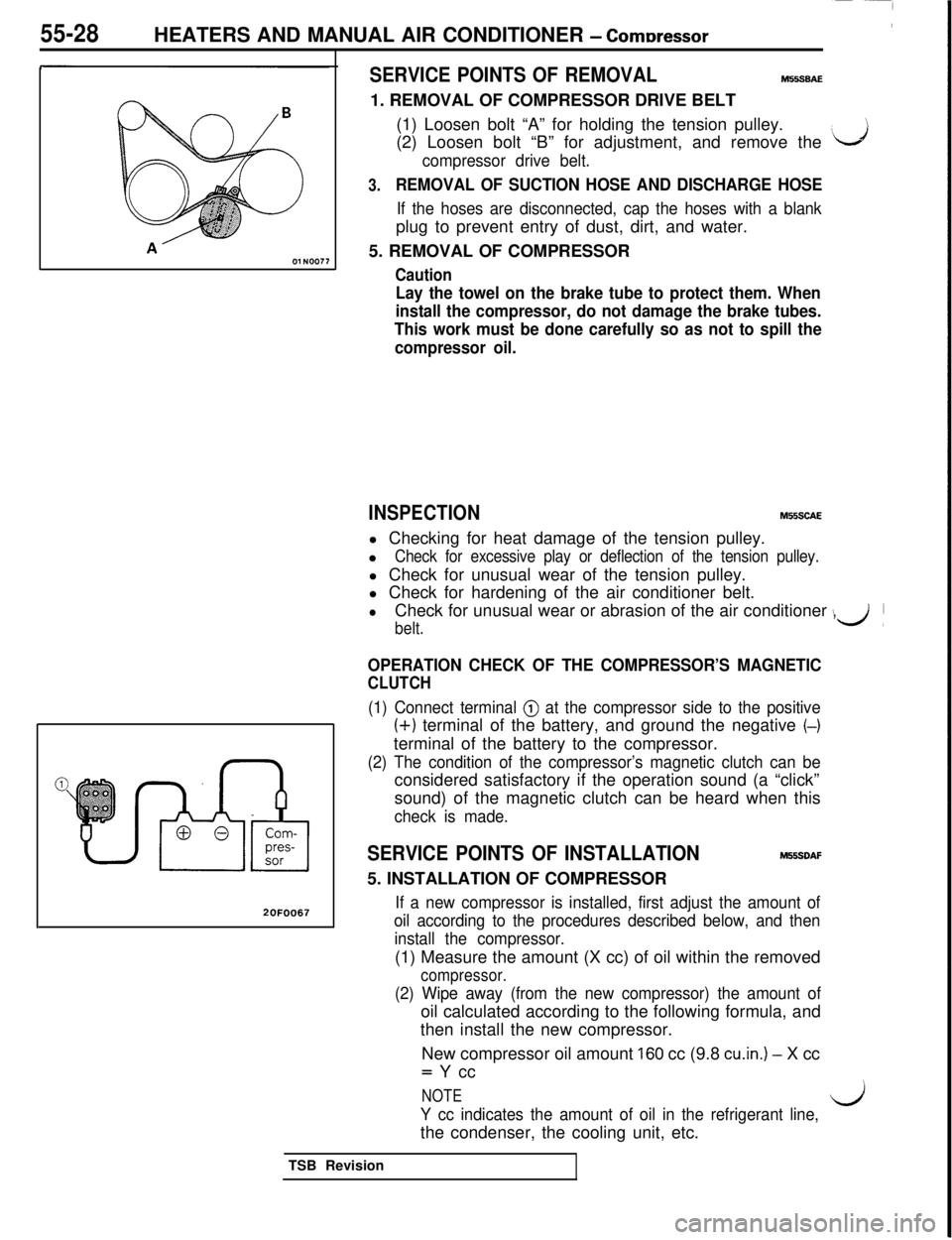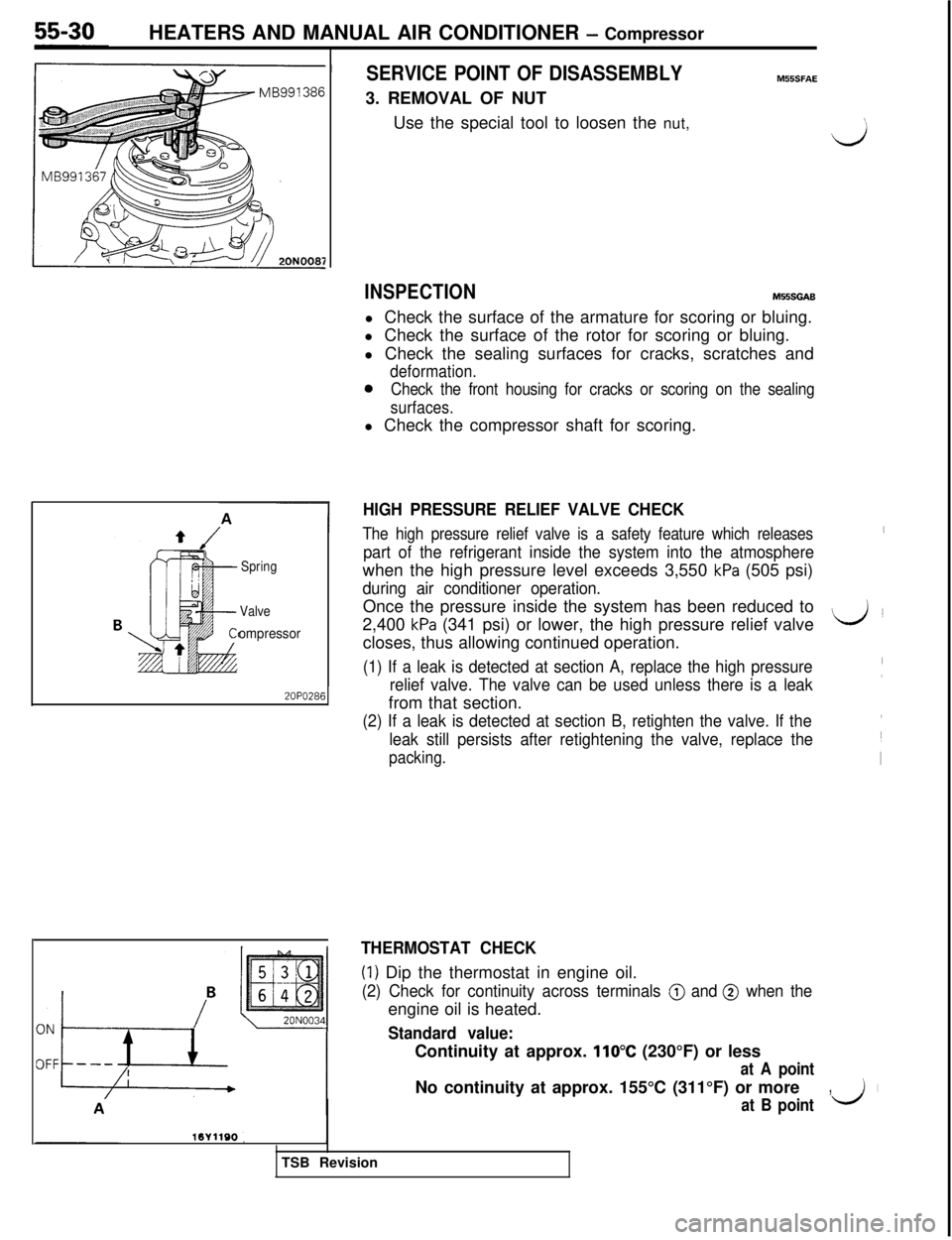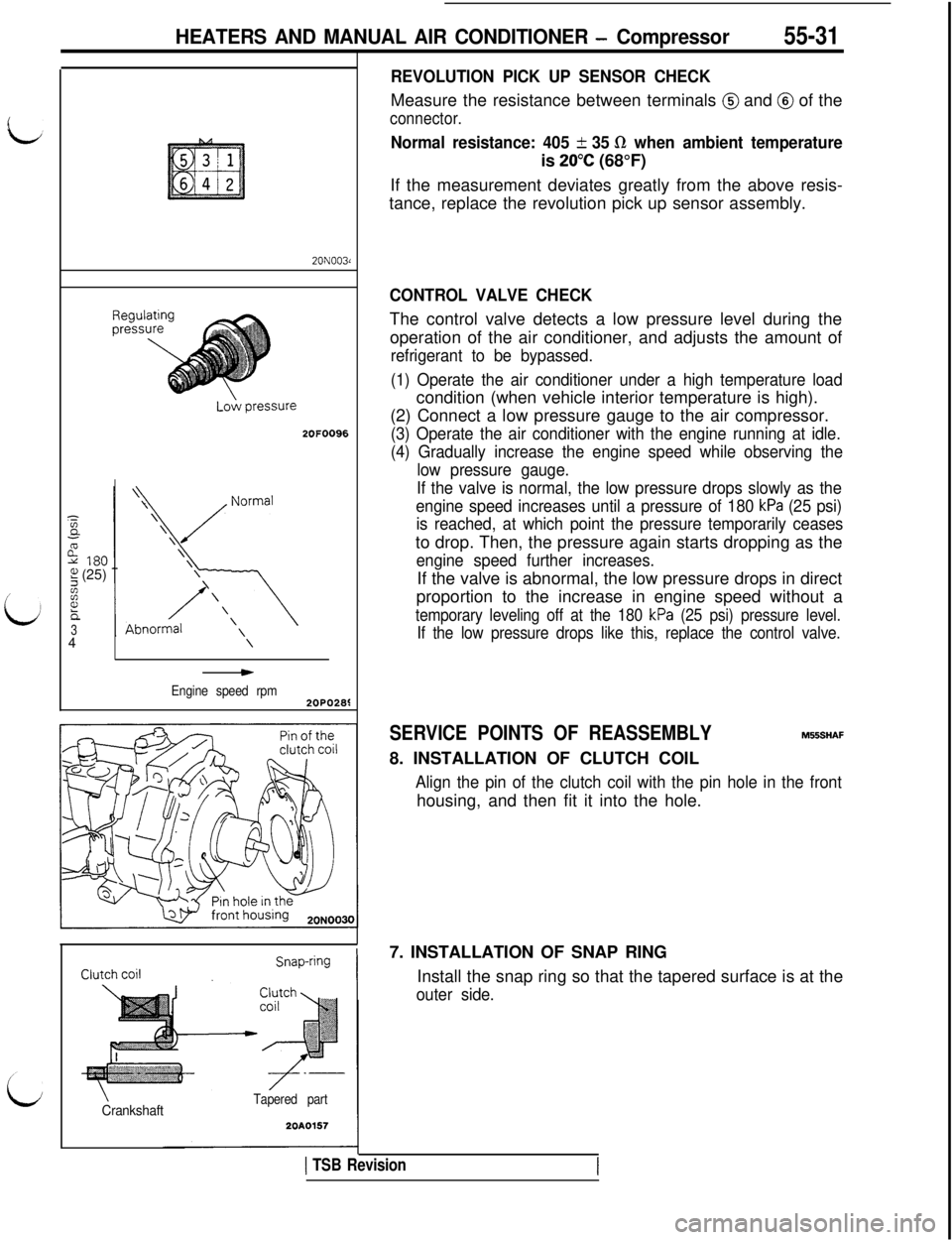Page 1109 of 1146
HEATERS AND MANUAL AIR CONDITIONER - Compressor55-27
COMPRESSOR
M55SA- -
/REMOVAL AND INSTALLATION
iJ
iPre-removal Operation
l Discharge of the Refrigerant(Refer to P.55-14.)9.0 Nm
7.Oft.lbs.
\Post-installation Operation
l Adjustment of the Compressor
Drive Belt (Refer to GROUP 11 -Service Adjustment Procedures.)l Charging of Refrigerant(Refer to P.55-11.)21 Nm
15 ftlbs.Removal steps
a*1. Compressor drive belt
2. Condenser fan motor assembly
4*3. Connection of suction hose and discharge
41) l +4. !%znator (Refer to GROUP l6-Alternator.)*I) l * 5. Compressor
6. Idler pulley
7. Compressor bracket
!I zorr-rion pulley assembly;
;: Fontsion pulley
12. Adjustment plate
13. Tension pulley bracket6
45 Nm
33 ft.lbs.
52ONOO89Compressor oil:
Freol S-83 or Suniso 5GS
TSB Revision
Page 1110 of 1146

55-28HEATERS AND MANUAL AIR CONDITIONER - Comtxessor
20F0067
SERVICE POINTS OF REMOVALM55SBAE1. REMOVAL OF COMPRESSOR DRIVE BELT
(1) Loosen bolt “A” for holding the tension pulley.
(2) Loosen bolt “B” for adjustment, and remove the
‘J
compressor drive belt.
3.REMOVAL OF SUCTION HOSE AND DISCHARGE HOSE
If the hoses are disconnected, cap the hoses with a blankplug to prevent entry of dust, dirt, and water.
5. REMOVAL OF COMPRESSOR
Caution
Lay the towel on the brake tube to protect them. When
install the compressor, do not damage the brake tubes.
This work must be done carefully so as not to spill the
compressor oil.
INSPECTIONM55SCAEl Checking for heat damage of the tension pulley.
l
Check for excessive play or deflection of the tension pulley.l Check for unusual wear of the tension pulley.
l Check for hardening of the air conditioner belt.
lCheck for unusual wear or abrasion of the air conditioner ,
belt.
\d’
OPERATION CHECK OF THE COMPRESSOR’S MAGNETIC
CLUTCH
(1) Connect terminal @ at the compressor side to the positive
(+) terminal of the battery, and ground the negative (-)terminal of the battery to the compressor.
(2) The condition of the compressor’s magnetic clutch can beconsidered satisfactory if the operation sound (a “click”
sound) of the magnetic clutch can be heard when this
check is made.
SERVICE POINTS OF INSTALLATIONM55SDAF5. INSTALLATION OF COMPRESSOR
If a new compressor is installed, first adjust the amount of
oil according to the procedures described below, and then
install the compressor.(1) Measure the amount (X cc) of oil within the removed
compressor.
(2) Wipe away (from the new compressor) the amount ofoil calculated according to the following formula, and
then install the new compressor.
New compressor oil amount
160 cc (9.8 cu.in.) - X cc= Y cc
NOTE
Y cc indicates the amount of oil in the refrigerant line,l/jthe condenser, the cooling unit, etc.
TSB Revision
Page 1111 of 1146
HEATERS AND MANUAL AIR CONDITIONER - Compressor
DISASSEMBLY AND REASSEMBLY
55-29
M55SE- -16
152OFOO97
Magnetic clutch disassembly steps
1. Bolts
2. Pulley
l * l *3. Nutl *4. Armature plate
gI i;yirring
l *7. Snap ringF* 8. Clutch coil9. ShimsControl valve disassembly
13. Snap ring14. Control valveThermostat and revolution pick up sensor disassem-
bly steps
15. Plate16. Thermostat and revolution pick up sensorHigh pressure relief valve disassembly steps
10. Cover11. Dust cover
12. High pressure relief valveTSB Revision
Page 1112 of 1146

HEATERS AND MANUAL AIR CONDITIONER - Compressor
Spring
Valve
ompressor
2OPO286~
SERVICE POINT OF DISASSEMBLYMSlSFAE3. REMOVAL OF NUT
Use the special tool to loosen the nut,
INSPECTIONM55SGABl Check the surface of the armature for scoring or bluing.
l Check the surface of the rotor for scoring or bluing.
l Check the sealing surfaces for cracks, scratches and
deformation.
0Check the front housing for cracks or scoring on the sealing
surfaces.l Check the compressor shaft for scoring.
J
HIGH PRESSURE RELIEF VALVE CHECK
The high pressure relief valve is a safety feature which releasesI
part of the refrigerant inside the system into the atmospherewhen the high pressure level exceeds 3,550
kPa (505 psi)
during air conditioner operation.Once the pressure inside the system has been reduced to
2,400
kPa (341 psi) or lower, the high pressure relief valveL&Jcloses, thus allowing continued operation.
(1) If a leak is detected at section A, replace the high pressure
relief valve. The valve can be used unless there is a leak(from that section.
(2) If a leak is detected at section B, retighten the valve. If the
leak still persists after retightening the valve, replace the
packing.
THERMOSTAT CHECK
(1) Dip the thermostat in engine oil.
(2) Check for continuity across terminals @ and @ when theengine oil is heated.
Standard value:Continuity at approx.
110°C (230°F) or less
at A pointNo continuity at approx. 155°C (311°F) or more
,I
at B pointII;TSB Revision
Page 1113 of 1146

HEATERS AND MANUAL AIR CONDITIONER - Compressor55-3120N003d
2OFOO96
I
Ec-3
3180?+I! (25)zz
h34\
*
Engine speed rpm2OPO2S
\CrankshaftTapered part
20A0157
REVOLUTION PICK UP SENSOR CHECKMeasure the resistance between terminals
@ and @ of the
connector.
Normal resistance: 405 + 35 R when ambient temperatureis
20°C (68°F)
If the measurement deviates greatly from the above resis-
tance, replace the revolution pick up sensor assembly.
CONTROL VALVE CHECKThe control valve detects a low pressure level during the
operation of the air conditioner, and adjusts the amount of
refrigerant to be bypassed.
(1) Operate the air conditioner under a high temperature loadcondition (when vehicle interior temperature is high).
(2) Connect a low pressure gauge to the air compressor.
(3) Operate the air conditioner with the engine running at idle.
(4) Gradually increase the engine speed while observing the
low pressure gauge.
If the valve is normal, the low pressure drops slowly as the
engine speed increases until a pressure of 180
kPa (25 psi)
is reached, at which point the pressure temporarily ceasesto drop. Then, the pressure again starts dropping as the
engine speed further increases.If the valve is abnormal, the low pressure drops in direct
proportion to the increase in engine speed without a
temporary leveling off at the 180 kPa (25 psi) pressure level.
If the low pressure drops like this, replace the control valve.
SERVICE POINTS OF REASSEMBLYM556HAF
8. INSTALLATION OF CLUTCH COIL
Align the pin of the clutch coil with the pin hole in the fronthousing, and then fit it into the hole.
7. INSTALLATION OF SNAP RING
Install the snap ring so that the tapered surface is at the
outer side.
1 TSB Revision
Page 1114 of 1146
55-32HEATERS AND MANUAL AIR CONDITIONER - Comrxessor
no spline-
Feeler gauge4. INSTALLATION OF ARMATURE PLATE
Align the mating mark of the crankshaft spline and the
mating mark of the armature plate, and then fit them
together.‘%(J3. INSTALLATION OF NUT(I) Use the special tool to tighten the nut.
(2) Check whether or not the air gap of the clutch is within
the standard value.Standard value: 0.4
- 0.6 mm (.Ol - .02 in.)
NOTE
If there is a deviation of the air gap from the standardvalue, make the necessary adjustment by adjusting the
d 1number of shims.
1 TSB Revision
Page 1115 of 1146
HEATERS AND MANUAL AIR CONDITIONER - ::“dE:; and Condenser55-33
CONDENSER AND CONDENSER FAN MOTOR
MFSTA-A
idREMOVAL AND
IlilSTALLATlONPre-removal and Post-installation
l Discharge and Charging of the Refrigerant
l Removal and lnsiallation of the Alternator(Refey to GROUP 16 -Alternator.)
6
f: Piplng connection
@
20N00890-ring
d-ringCompressor oil: Freol S-83 or Suniso 5GS
9-11 Nm
7.0 - 8.0 ftlbs.
9’23’Nm17 ft.lbs.
asset-rRemoval steps1. Condenser fan motor
2. Fan
3. Motor assembly
4. Shroud
w w 5. Radiator fan motor assembly(Refer to GROUP 14- Radiator.)
Insulator installationbolts
6.4*7. Liquid pipe A and liquid pipe Bl *8. Condenser9.Bushings
/9.0 7.0ft.lbs. Nm2OFOO28
SERVICE POINTS OF REMOVALM!XTEtAC7. REMOVAL OF LIQUID
‘PIPE A AND LIQUID HOSE B
(1) Loosen the flare nut by using two wrenches.
(2) Plug the disconnected hose and pipes and the openingsof the condenser in order to prevent dust, dirt and other
foreign material from entering.
TSB Revision
Page 1116 of 1146
55-34HEATERS AND MANUAL AIR CONDITIONER - :t%%: and Condenser8. REMOVAL OF CONDENSER
Move the radiator toward the engine, and then remove the
condenser upward.
d
INSPECTIONM55TCAKl Check the condenser fan for crushing or other damage.
l Check the condenser’s high-pressure hose and pipe in-
stallation parts for damage or deformation.
l Check the condenser fan shroud for damage.
CONDENSER FAN MOTOR CHECK
(1) Apply battery voltage to terminal @and ground terminal 8;at this time, check that the condenser fan motor turns.
(2) Apply battery voltage to terminal @and ground terminal 0;at this time, check that the condenser fan motor turns.
TSB Revision